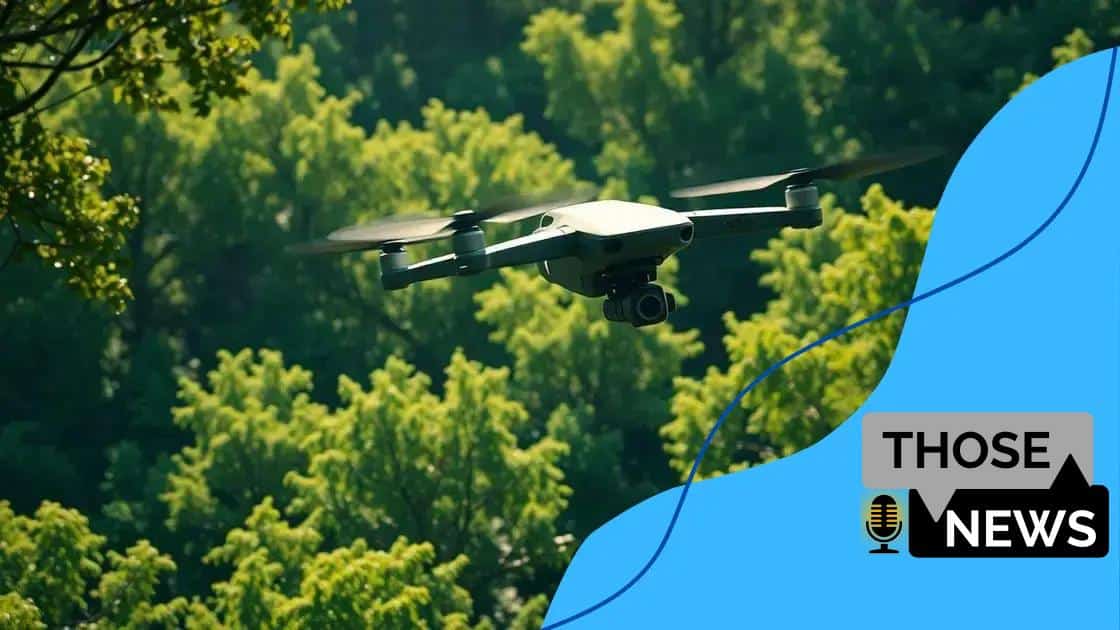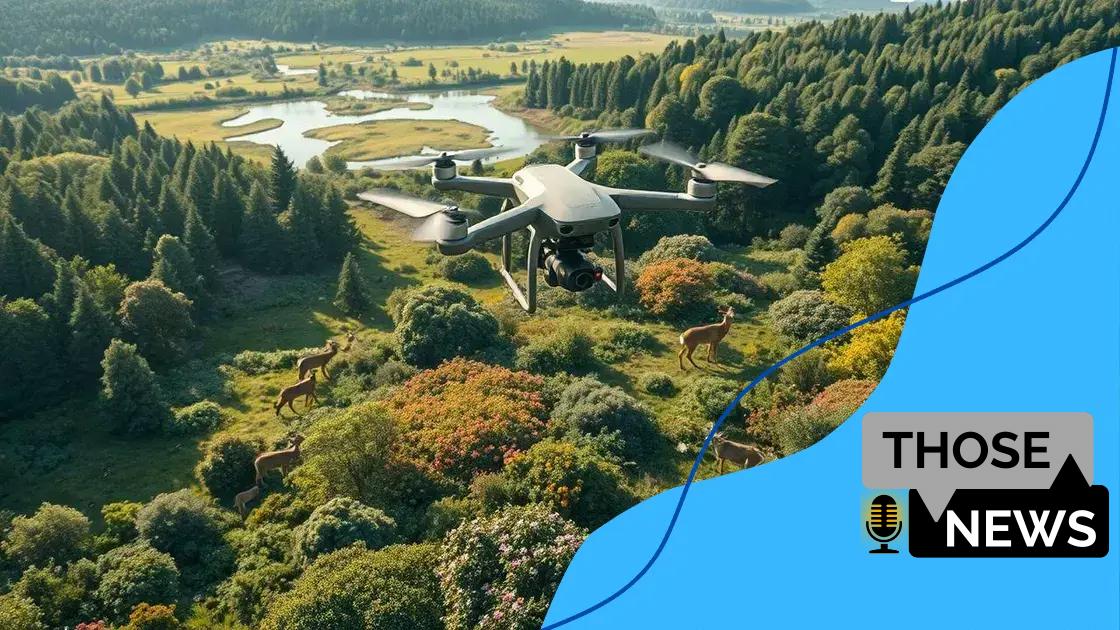Drone technology for environmental monitoring and conservation

Drone technology for environmental monitoring offers efficient data collection, advanced analytics through AI, and improved conservation strategies, transforming how we observe and protect natural resources.
Drone technology for environmental monitoring is transforming how we observe and protect our planet. Imagine using aerial imagery to track wildlife or assess deforestation. In this article, we delve into how drones are revolutionizing our approach to environmental conservation.
Understanding drone technology
Understanding drone technology is crucial for leveraging its full potential in environmental monitoring. Drones, also known as unmanned aerial vehicles (UAVs), are equipped with advanced technology that allows them to perform various tasks efficiently. They provide an innovative approach to collecting data and monitoring ecological changes.
Drones come with different features depending on their intended use. For instance, some drones are equipped with cameras that capture high-resolution images, while others have sensors that measure environmental factors like temperature and humidity.
Types of Drones for Environmental Monitoring
There are several types of drones suitable for environmental purposes. The main categories include:
- Fixed-wing drones for long-distance flights.
- Multi-rotor drones for precision and versatility.
- Hybrid drones that combine features of both types.
This variety allows researchers and conservationists to choose a drone that best suits their specific needs. As technology advances, new features are constantly being integrated into these flying machines, enhancing their effectiveness.
Drones utilize GPS technology, which enables precise navigation and data collection. This precision is essential in tasks such as mapping land use or monitoring wildlife populations. The use of drones in various environmental studies has grown significantly, providing a safer and more efficient alternative to traditional methods.
Benefits of Drones in Data Collection
The benefits of using drones for environmental monitoring are numerous. Some key advantages include:
- Cost-effectiveness compared to manned aircraft.
- Ability to access hard-to-reach or dangerous areas safely.
- Quick deployment and ability to gather large amounts of data rapidly.
These characteristics make drones an ideal tool for scientists and conservationists alike. Whether it’s monitoring deforestation, studying wildlife migration patterns, or assessing vegetation health, the impact of drone technology on environmental science can’t be overstated.
In conclusion, a solid understanding of drone technology opens the door to innovative solutions in environmental monitoring. As the technology evolves, so will its applications, making it an exciting area to watch in the coming years.
Applications of drones in environmental monitoring
The applications of drones in environmental monitoring are diverse and impactful. Drones provide a unique perspective that is often difficult to achieve through traditional methods. They can fly over vast areas, capturing real-time data that helps in understanding changes in the environment.
One of the most prominent uses of drones is in agriculture. Farmers employ drones to monitor crop health, assess irrigation needs, and analyze soil conditions. By using aerial imagery, farmers can identify issues before they become larger problems.
Wildlife Monitoring
Drones are also widely used for wildlife monitoring. They enable conservationists to observe animals without causing disturbance. For example, drones can track the movements of endangered species in their natural habitat. This technology helps in collecting data on population sizes and health, which is vital for conservation efforts.
- Drones can cover large areas quickly.
- They allow for non-intrusive observation of wildlife.
- Data collected can be used for research and policy-making.
In the realm of environmental protection, drones are employed to monitor pollution levels. They can assess air and water quality, helping authorities respond promptly to environmental hazards. By gathering data from hard-to-reach locations, they play a crucial role in managing and protecting natural resources.
Disaster Management
Another critical application of drones is in disaster management. After natural disasters, drones provide immediate data to assess damage. This information assists emergency responders in planning and executing rescue operations.
Drones can also be used to create maps of affected areas, enhancing recovery efforts. Their ability to operate in hazardous conditions makes them invaluable in crisis situations.
Each application illustrates how drone technology is reshaping environmental monitoring. As technology continues to advance, the potential uses for drones in this field are likely to grow, offering even more tools for conservation and monitoring efforts.
Benefits of using drones for conservation

The benefits of using drones for conservation are substantial and transformative. Drones offer a fresh perspective on how we approach environmental protection. They enable conservationists to gather crucial data quickly and efficiently, which is vital for making informed decisions.
One major advantage is the ability to monitor large areas without disturbing wildlife. Traditional methods often require a physical presence that can disrupt animal behavior, but drones can fly above and capture detailed images or videos without interference.
Cost-Effectiveness
Using drones can significantly reduce costs compared to other monitoring methods. Employing manned aircraft or terrestrial surveys can incur high expenses, including fuel, labor, and equipment maintenance. Drones are more affordable to operate, making them accessible for a wide range of conservation projects.
- Drones require less manpower for monitoring tasks.
- They can cover vast areas in a short time.
- Operational costs are lower than traditional methods.
In addition, drones provide high-resolution imagery and actionable data. This precision helps in tracking changes in ecosystems and identifying specific areas that require immediate attention. For instance, drones can spot illegal logging or poaching activities from above, allowing for quick intervention.
Improved Data Collection
The level of detail obtained from drone imagery is unmatched. Drones equipped with advanced sensors can capture data on soil quality, vegetation health, and wildlife populations. This information helps create comprehensive models for understanding environmental dynamics.
Drones enhance the accuracy of monitoring efforts. With GPS technology, they can return to exact locations for consistent observations. This repeatability is essential for tracking changes over time and assessing the effectiveness of conservation strategies.
Ultimately, the integration of drones into conservation practices is revolutionizing the field. As more organizations adopt this technology, the potential for positive environmental impact increases significantly. The future of conservation is becoming more efficient and effective, thanks to drones and their unique capabilities.
Challenges faced in drone deployment
The challenges faced in drone deployment are significant and can impact their effectiveness in environmental monitoring. While drones are powerful tools, various hurdles must be navigated to ensure success.
One primary concern is regulatory restrictions. Many countries have specific laws governing drone usage, including limitations on where and how high they can fly. These regulations can hinder the ability to deploy drones in remote or sensitive areas, slowing down conservation efforts.
Technical Limitations
Technical challenges also pose issues for drone operators. Drones may face limitations in battery life, which restricts their flight duration and range. A drone needs to return to its launch point before the battery runs out, which can limit data collection efforts.
- Weather conditions can affect flight safety and data quality.
- GPS signal loss can disrupt navigation and data gathering.
- Payload restrictions limit the types of sensors that can be used.
Moreover, environmental factors can pose problems. For instance, strong winds and rain can make it difficult to fly drones safely. This unpredictability requires operators to keep a close eye on weather forecasts and plan flights accordingly.
Data Management Issues
After deployment, managing the data collected by drones can be a daunting task. The volume of data can be overwhelming, requiring significant storage and processing capabilities. Teams must be equipped to analyze this data effectively to draw meaningful conclusions.
Additionally, ensuring data accuracy and reliability is essential. Errors in data collection can lead to misguided conservation strategies. It is crucial for operators to follow standardized methods and regularly calibrate their equipment.
Each of these challenges highlights the need for careful planning, training, and adaptability in drone deployment. Overcoming these hurdles is essential for maximizing the benefits that drone technology can offer to environmental monitoring and conservation efforts.
Future trends in drone technology for the environment
The future trends in drone technology for the environment promise to revolutionize how we monitor and protect natural resources. As technology continues to advance, drones are becoming more sophisticated and versatile in their applications.
One significant trend is the integration of artificial intelligence (AI) with drone operations. AI can enhance the way drones analyze data, enabling them to identify patterns and anomalies in real-time. This capability will allow conservationists to respond faster to environmental changes and threats.
Enhanced Data Collection
Another exciting development is the improved sensors and imaging technologies being incorporated into drones. For instance, multispectral and hyperspectral sensors can now capture detailed information about plant health and soil conditions. This data is crucial for understanding ecosystem dynamics.
- Drones will use better imaging technology for precise data gathering.
- Applications in precision agriculture will help farmers optimize field management.
- Advanced sensors will allow for deeper insights into environmental changes.
Moreover, the growing availability of open-source drone platforms encourages collaboration among researchers and environmentalists. These platforms allow anyone to access and improve drone technology, leading to innovative solutions for conservation challenges.
Increased Regulatory Support
As drone technology develops, regulatory frameworks are also evolving. Governments are beginning to recognize the benefits of drones for environmental monitoring. As a result, we can expect more supportive regulations that facilitate the responsible use of drones.
These changes may include streamlined approval processes for drone use, especially in conservation areas. Improved regulation will enable teams to deploy drones in critical situations faster, enhancing their ability to protect wildlife and habitats.
Additionally, the future may see the rise of autonomous drones that can perform complex tasks without human intervention. These drones could be programmed to monitor specific areas continuously, providing ongoing data collection that is invaluable for long-term environmental studies.
As we look ahead, the potential of drone technology in environmental monitoring expands significantly. With continuous advancements, these tools will play an essential role in addressing environmental challenges and promoting sustainability across the globe.
FAQ – Frequently Asked Questions about Drone Technology in Environmental Monitoring
What are the main benefits of using drones for environmental monitoring?
Drones provide cost-effective data collection, non-intrusive wildlife observation, and the ability to cover large areas quickly.
How does artificial intelligence enhance drone technology?
AI helps drones analyze data more efficiently and identify trends in real-time, allowing for quicker responses to environmental changes.
What challenges do drones face in deployment for conservation efforts?
Drones encounter regulatory restrictions, technical limitations like battery life, and data management issues that must be addressed.
What future trends can we expect in drone technology for environmental protection?
Expect advancements in sensors, more supportive regulations, and the rise of autonomous drones for continuous monitoring.





